The Transport Management System Market is estimated to be valued at USD 19.6 billion in 2025 and is projected to reach USD 109.8 billion by 2035, registering a compound annual growth rate (CAGR) of 18.8% over the forecast period.
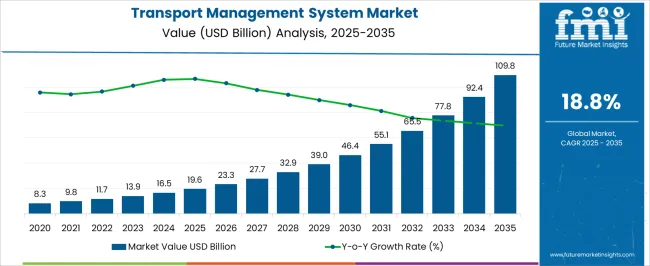
| Metric | Value |
|---|---|
| Transport Management System Market Estimated Value in (2025 E) | USD 19.6 billion |
| Transport Management System Market Forecast Value in (2035 F) | USD 109.8 billion |
| Forecast CAGR (2025 to 2035) | 18.8% |
The transport management system market is growing steadily as global supply chains become more complex and demand for digitally enabled logistics platforms intensifies. Adoption is being accelerated by the need for operational visibility, real-time tracking, and cost optimization in transportation networks. Continuous advancements in cloud computing, artificial intelligence, and predictive analytics are strengthening system capabilities, enabling enterprises to manage multi-modal transport operations with higher accuracy and efficiency.
Regulatory requirements on sustainability and carbon footprint reporting are also influencing businesses to implement digital transport solutions that reduce inefficiencies and optimize resource use. The expansion of e-commerce, coupled with the rising importance of last-mile delivery, is further shaping demand for advanced transport management systems.
Integration with enterprise resource planning and warehouse management platforms is being prioritized to enhance supply chain transparency and coordination As global logistics networks expand and competition intensifies, investment in transport management systems is expected to remain a critical enabler of growth, efficiency, and resilience across industries.
The transport management system market is segmented by feature, application, type of license, transportation mode, and geographic regions. By feature, transport management system market is divided into Planning & Optimization, Execution, and Visibility & Performance Mgmt. In terms of application, transport management system market is classified into Transport Sourcing, Capacity Management, Performance Management, Network Design, Shipping Consolidation, and Route Planning. Based on type of license, transport management system market is segmented into Hosted Licensing, On-Premises Licensing, and On-Premises Hosted Licensing. By transportation mode, transport management system market is segmented into Roadways, Railways, Airways, and Seaways. Regionally, the transport management system industry is classified into North America, Latin America, Western Europe, Eastern Europe, Balkan & Baltic Countries, Russia & Belarus, Central Asia, East Asia, South Asia & Pacific, and the Middle East & Africa.
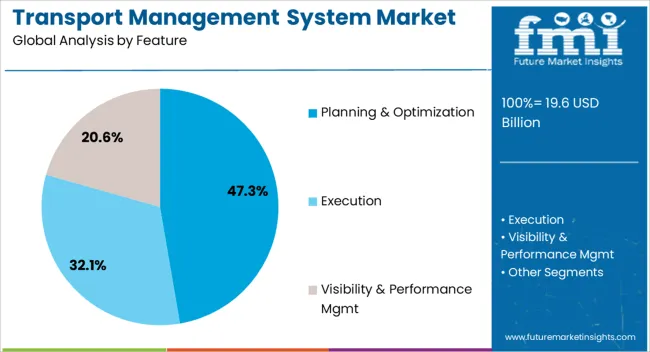
The planning and optimization feature segment is projected to hold 47.3% of the transport management system market revenue share in 2025, making it the leading feature category. Its leadership is being driven by the ability to enhance routing efficiency, reduce fuel costs, and improve delivery timelines. Companies are increasingly focusing on real-time optimization to manage fluctuating demand patterns and mitigate disruptions in transportation networks.
Advanced algorithms and AI-powered modules are being integrated into planning and optimization features, enabling dynamic scheduling, automated route planning, and resource allocation. These tools are proving critical in addressing rising logistics costs and the need for on-time delivery in highly competitive markets.
Adoption is being reinforced by enterprises seeking to improve operational sustainability, as optimized transport routes contribute directly to lower carbon emissions The ability of this feature to deliver measurable cost savings and performance improvements is solidifying its role as the most critical functionality within transport management systems, ensuring continued dominance in the global market.
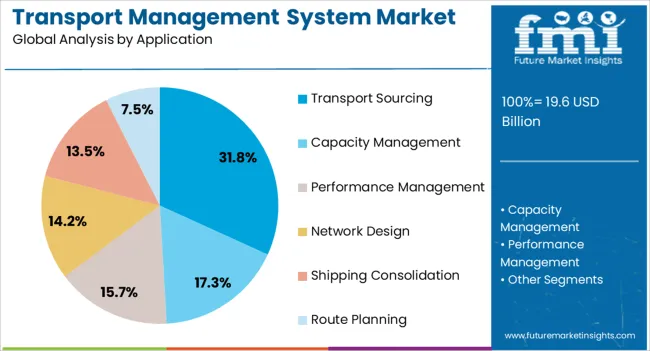
The transport sourcing application segment is anticipated to account for 31.8% of the transport management system market revenue share in 2025, establishing it as the leading application. This dominance is being reinforced by the rising need for businesses to optimize carrier selection and procurement strategies in increasingly competitive logistics markets. Transport sourcing modules enable organizations to evaluate service providers, negotiate contracts, and allocate freight based on performance, cost, and compliance criteria.
The growing complexity of global supply chains, alongside heightened expectations for service reliability, is encouraging widespread adoption of sourcing applications. Enterprises are also prioritizing these tools to gain greater transparency into freight costs and improve supplier collaboration.
By enabling data-driven decisions, transport sourcing applications are playing a pivotal role in improving procurement efficiency and strengthening relationships with logistics partners As cost control and resilience remain strategic priorities for enterprises, the use of transport sourcing applications is expected to continue expanding, reinforcing its leadership position in the market.
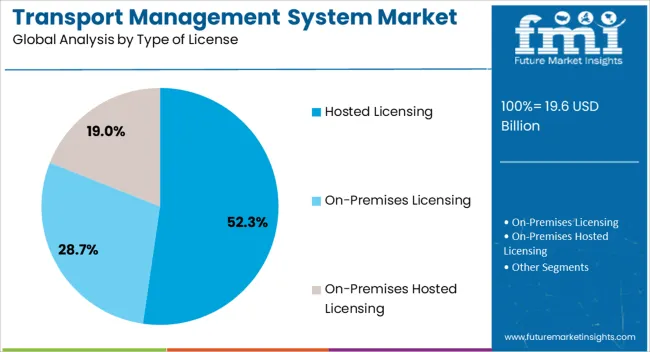
The hosted licensing type segment is expected to represent 52.3% of the transport management system market revenue share in 2025, positioning it as the dominant licensing model. This leadership is being driven by the rapid shift toward cloud-based deployment, which offers flexibility, scalability, and lower upfront investment compared to traditional on-premises solutions. Businesses are increasingly adopting hosted licensing to support geographically dispersed operations and ensure seamless access to transport management systems through web-enabled platforms.
The subscription-based nature of hosted licensing also aligns with enterprise preferences for predictable operating expenses and simplified software management. Regular updates, security enhancements, and integrations with third-party systems are more efficiently delivered through hosted environments, reinforcing adoption across small, medium, and large enterprises.
Growing emphasis on digital transformation and cost optimization in logistics is further accelerating demand for hosted models As organizations seek to future-proof their operations and manage transport complexities with agility, hosted licensing is expected to remain the preferred approach, maintaining its market-leading position.
A transport management system (TMS) tailored for drivers is a sophisticated software platform that serves as the backbone of transportation logistics operations. It encompasses a wide range of functionalities aimed at optimizing the efficiency, safety, and compliance of driver-centric tasks within the logistics and supply chain management ecosystem.
Its capability to automate and streamline driver scheduling and dispatching processes. This includes assigning drivers to specific trips based on factors such as availability, location, vehicle type, and driver qualifications. By automating these tasks, the TMS ensures that resources are allocated optimally, minimizing downtime and maximizing utilization.
Route optimization is another critical aspect facilitated by a TMS. The system calculates the most efficient routes for drivers considering various parameters such as traffic patterns, road conditions, delivery schedules, and even weather forecasts.
Real-time updates and dynamic rerouting capabilities allow the TMS to adapt quickly to unexpected changes, ensuring on-time deliveries while reducing fuel consumption and vehicle wear and tear.
In terms of compliance and safety management, a TMS helps organizations adhere to regulatory requirements and safety standards. It tracks and monitors drivers' hours of service (HOS) to prevent violations, ensuring compliance with regulations such as the Hours of Service (HOS) rules mandated by government agencies.
Additionally, the TMS may include features for monitoring driving behaviors, such as speeding or harsh braking, promoting safe driving practices and reducing the risk of accidents.
Effective communication tools are integrated into the TMS to facilitate real-time communication between drivers and dispatchers. Mobile applications or in-cab devices allow drivers to receive trip assignments, update their status, report issues, and communicate with dispatchers seamlessly.
This ensures that drivers remain informed and connected throughout their routes, enhancing overall operational efficiency and responsiveness to customer needs.
Moreover, a TMS for drivers provides robust reporting and analytics capabilities. It generates detailed performance metrics and KPIs related to driver performance, vehicle utilization, delivery accuracy, and operational efficiency. These insights enable transportation managers to identify trends, pinpoint areas for improvement, and make data-driven decisions to optimize fleet management and logistics operations.
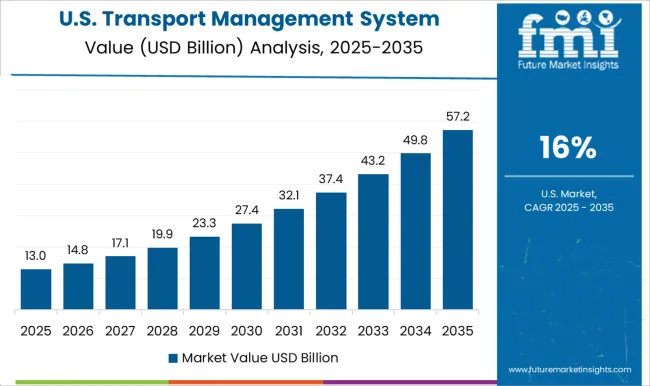
In the United States, the demand for Transport Management Systems (TMS) is driven by the need for enhanced logistics efficiency in a vast and complex transportation network. TMS solutions are widely adopted across various industries, including retail, manufacturing, and distribution, to optimize freight management, reduce transportation costs, and improve delivery reliability.
With a strong emphasis on leveraging technology to streamline operations, the United States. businesses seek TMS platforms that offer advanced features such as real-time visibility, route optimization, and integration with IoT (Internet of Things) and telematics devices.
The fierce competition encourages innovation among TMS providers, leading to solutions tailored to meet specific industry requirements and compliance standards such as FMCSA regulations. The growth in e-commerce further fuels demand, as companies strive to meet customer expectations for fast and transparent delivery processes.
Overall, the United States market for TMS is characterized by its maturity, technological sophistication, and continuous evolution toward more integrated and intelligent transportation management solutions.
In the United Kingdom, the adoption of Transport Management Systems (TMS) is on the rise as companies seek to optimize supply chain operations amidst evolving logistical challenges. TMS solutions play a crucial role in managing freight movements across the country and internationally, facilitating better route planning, vehicle utilization, and compliance with regulatory requirements such as DVSA standards.
Increasing competition in the market encourages TMS providers to innovate with features like cloud-based platforms, mobile applications for real-time updates, and integration capabilities with ERP systems. Industries such as retail, pharmaceuticals, and automotive rely heavily on TMS to streamline distribution networks and enhance customer service through improved delivery times and tracking capabilities.
The United Kingdom's TMS industry is characterized by a focus on sustainability, cost-efficiency, and scalability, with businesses leveraging technology to achieve operational excellence and competitive advantage in a rapidly changing global market.
In China, the demand for Transport Management Systems (TMS) is experiencing rapid growth fueled by the country's ambitious logistics modernization initiatives and expanding e-commerce sector. TMS solutions are instrumental in managing the complexities of China's vast transportation network, optimizing freight routes, and improving delivery efficiency across urban and rural areas.
With a focus on integrating advanced technologies such as AI (Artificial Intelligence), big data analytics, and IoT devices, Chinese businesses are enhancing logistics visibility, reducing transportation costs, and ensuring regulatory compliance.
From manufacturing to retail to food and beverage logistics, the dynamic market landscape encourages TMS providers to innovate. Government support for digital transformation initiatives further accelerates TMS adoption, driving efficiency gains and operational transparency throughout the supply chain.
Overall, the TMS market in China is characterized by its dynamic growth, technological innovation, and strategic importance in supporting the country's ambitious economic development goals through enhanced logistics capabilities.
Premises licensing, particularly for businesses involved in logistics and transportation, plays a significant role in driving the adoption of Transport Management Systems (TMS). This form of licensing necessitates stringent compliance with regulatory requirements, operational efficiency, and accurate documentation, all of which can be effectively managed through a robust TMS.
TMS adoption is primarily driven by regulatory compliance, which is one of the primary reasons premises licensing drives the adoption of TMS. Logistics and transportation companies must adhere to various local, state, and federal regulations that govern vehicle operations, driver working hours, and safety standards.
A TMS helps these companies ensure compliance by automating the tracking of regulatory requirements, generating necessary reports, and providing alerts for non-compliance issues. This reduces the risk of penalties and enhances the company's reputation for adhering to legal standards.
Premises licensing often requires meticulous record-keeping and reporting to authorities. Transport Management Systems streamline this process by centralizing all relevant data, such as vehicle maintenance logs, driver records, and shipment tracking information.
This centralization facilitates easy access and retrieval of data, ensuring that companies can promptly provide accurate reports to licensing authorities as required.
The extensive network of roadways plays a crucial role in driving the adoption of Transport Management Systems (TMS). As road transportation remains a dominant mode of freight movement, managing the complexities and challenges associated with roadway logistics has become paramount.
TMS solutions provide the necessary tools to optimize route planning, enhance real-time tracking, and improve overall efficiency in road transport operations.
One significant factor is the need for route optimization. With varying traffic patterns, road conditions, and delivery schedules, a TMS helps in planning the most efficient routes, reducing fuel consumption and transit times. This not only cuts operational costs but also ensures timely deliveries, which is critical for customer satisfaction in today's fast-paced market.
Real-time tracking capabilities offered by TMS are another driving factor. Roadway transport often involves unpredictable variables such as traffic jams, road closures, and weather conditions.
TMS solutions enable real-time monitoring of vehicle locations, allowing companies to respond swiftly to any disruptions. This enhanced visibility ensures better management of delivery timelines and resources.
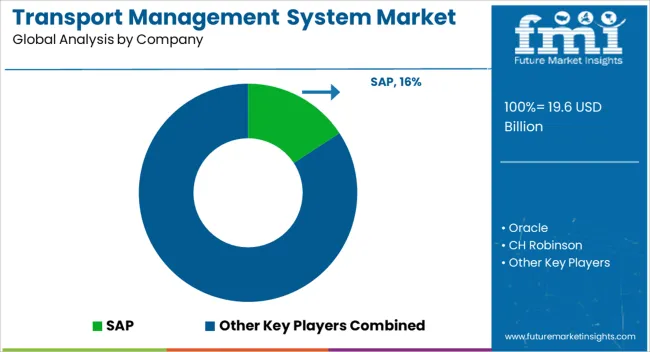
Key players in the transport management system are employing a variety of strategies to stay competitive, enhance their offerings, and address the evolving needs of their customers. These strategies encompass technological innovation, strategic partnerships, market expansion, and a focus on customer-centric solutions.
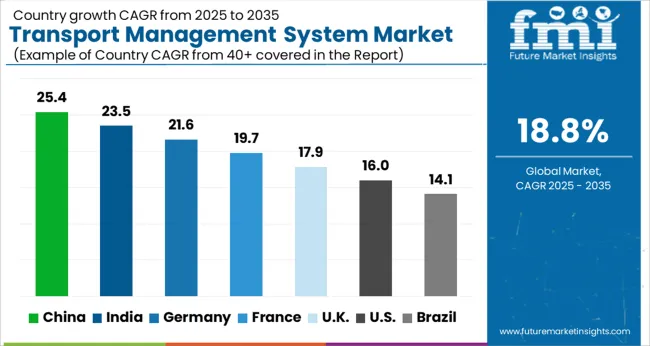
| Country | CAGR |
|---|---|
| China | 25.4% |
| India | 23.5% |
| Germany | 21.6% |
| France | 19.7% |
| UK | 17.9% |
| USA | 16.0% |
| Brazil | 14.1% |
The Transport Management System Market is expected to register a CAGR of 18.8% during the forecast period, exhibiting varied country level momentum. China leads with the highest CAGR of 25.4%, followed by India at 23.5%. Developed markets such as Germany, France, and the UK continue to expand steadily, while the USA is likely to grow at consistent rates. Brazil posts the lowest CAGR at 14.1%, yet still underscores a broadly positive trajectory for the global Transport Management System Market. In 2024, Germany held a dominant revenue in the Western Europe market and is expected to grow with a CAGR of 21.6%. The USA Transport Management System Market is estimated to be valued at USD 6.9 billion in 2025 and is anticipated to reach a valuation of USD 30.3 billion by 2035. Sales are projected to rise at a CAGR of 16.0% over the forecast period between 2025 and 2035. While Japan and South Korea markets are estimated to be valued at USD 951.3 million and USD 672.7 million respectively in 2025.
| Item | Value |
|---|---|
| Quantitative Units | USD 19.6 Billion |
| Feature | Planning & Optimization, Execution, and Visibility & Performance Mgmt |
| Application | Transport Sourcing, Capacity Management, Performance Management, Network Design, Shipping Consolidation, and Route Planning |
| Type of License | Hosted Licensing, On-Premises Licensing, and On-Premises Hosted Licensing |
| Transportation Mode | Roadways, Railways, Airways, and Seaways |
| Regions Covered | North America, Europe, Asia-Pacific, Latin America, Middle East & Africa |
| Country Covered | United States, Canada, Germany, France, United Kingdom, China, Japan, India, Brazil, South Africa |
| Key Companies Profiled | SAP, Oracle, CH Robinson, Manhattan Associates, Trimble, Wise Tech Global, Descartes, E2open, 3Gtms, BlueRock Logistics, and DDS Logistics |
The global transport management system market is estimated to be valued at USD 19.6 billion in 2025.
The market size for the transport management system market is projected to reach USD 109.8 billion by 2035.
The transport management system market is expected to grow at a 18.8% CAGR between 2025 and 2035.
The key product types in transport management system market are planning & optimization, execution and visibility & performance mgmt.
In terms of application, transport sourcing segment to command 31.8% share in the transport management system market in 2025.






Our Research Products

The "Full Research Suite" delivers actionable market intel, deep dives on markets or technologies, so clients act faster, cut risk, and unlock growth.

The Leaderboard benchmarks and ranks top vendors, classifying them as Established Leaders, Leading Challengers, or Disruptors & Challengers.

Locates where complements amplify value and substitutes erode it, forecasting net impact by horizon

We deliver granular, decision-grade intel: market sizing, 5-year forecasts, pricing, adoption, usage, revenue, and operational KPIs—plus competitor tracking, regulation, and value chains—across 60 countries broadly.

Spot the shifts before they hit your P&L. We track inflection points, adoption curves, pricing moves, and ecosystem plays to show where demand is heading, why it is changing, and what to do next across high-growth markets and disruptive tech

Real-time reads of user behavior. We track shifting priorities, perceptions of today’s and next-gen services, and provider experience, then pace how fast tech moves from trial to adoption, blending buyer, consumer, and channel inputs with social signals (#WhySwitch, #UX).

Partner with our analyst team to build a custom report designed around your business priorities. From analysing market trends to assessing competitors or crafting bespoke datasets, we tailor insights to your needs.
Supplier Intelligence
Discovery & Profiling
Capacity & Footprint
Performance & Risk
Compliance & Governance
Commercial Readiness
Who Supplies Whom
Scorecards & Shortlists
Playbooks & Docs
Category Intelligence
Definition & Scope
Demand & Use Cases
Cost Drivers
Market Structure
Supply Chain Map
Trade & Policy
Operating Norms
Deliverables
Buyer Intelligence
Account Basics
Spend & Scope
Procurement Model
Vendor Requirements
Terms & Policies
Entry Strategy
Pain Points & Triggers
Outputs
Pricing Analysis
Benchmarks
Trends
Should-Cost
Indexation
Landed Cost
Commercial Terms
Deliverables
Brand Analysis
Positioning & Value Prop
Share & Presence
Customer Evidence
Go-to-Market
Digital & Reputation
Compliance & Trust
KPIs & Gaps
Outputs
Full Research Suite comprises of:
Market outlook & trends analysis
Interviews & case studies
Strategic recommendations
Vendor profiles & capabilities analysis
5-year forecasts
8 regions and 60+ country-level data splits
Market segment data splits
12 months of continuous data updates
DELIVERED AS:
PDF EXCEL ONLINE
Cloud Systems Management Software Market Size and Share Forecast Outlook 2025 to 2035
Light Management System Market Size and Share Forecast Outlook 2025 to 2035
Labor Management System In Retail Market Size and Share Forecast Outlook 2025 to 2035
Stool Management System Market Analysis - Size, Share, and Forecast Outlook 2025 to 2035
Power Management System Market Analysis - Size, Share, and Forecast Outlook 2025 to 2035
Systems Administration Management Tools Market Size and Share Forecast Outlook 2025 to 2035
Alarm Management System Market Analysis by Component, Industry and Region - Trends, Growth & Forecast 2025 to 2035
Crowd Management System Market
Asset Management System Market
Dealer Management System Market Size and Share Forecast Outlook 2025 to 2035
Outage Management System Market Insights – Forecast 2025-2035
Energy Management System Market Analysis – Growth & Forecast 2017-2025
Freight Transport Management Market Size and Share Forecast Outlook 2025 to 2035
Catalog Management System Market Size and Share Forecast Outlook 2025 to 2035
Battery Management System Market Report – Growth & Forecast 2025-2035
Visitor Management System Market Analysis – Size, Share & Forecast 2025 to 2035
Traffic Management System Market Analysis – Demand, Growth & Forecast 2025–2035
Cooling Management System Market - Growth & Demand 2025 to 2035
Insulin Management System Market Growth - Trends & Forecast 2025 to 2035
Competitive Breakdown of Battery Management System Providers

Thank you!
You will receive an email from our Business Development Manager. Please be sure to check your SPAM/JUNK folder too.
Chat With
MaRIA